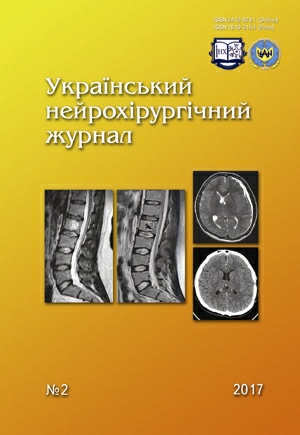Comparative assessment of clinical peculiarities of severe cerebrocranial trauma in benign and mortal outcome
DOI:
https://doi.org/10.25305/unj.104502Keywords:
cerebrocranial trauma, clinical progression, outcomeAbstract
The aim of the paper was to compare clinical peculiarities of severe cerebrocranial trauma in benign and mortal outcome.
Materials and methods. The paper analyzed 299 case histories of patients with severe cerebrocranial trauma, treated in Neurosurgical Department of Kharkiv Regional Clinical hospital from 2010 to 2013.
Results. The patients who died due to severe cerebrocranial trauma were found to be hospitalized in severe condition confirmed by indices of Glasgow Coma Scale, DRS and RTS, large pathological substrates, a great number of lesions of the brain and displacement of medial structures.
Conclusions. Statistically significant predicators of mortal outcome are low indices of Glasgow Coma Scale and RTS during hospital admission as well as large pathological substrates, their number and localization, significant displacement of medial structures of the brain.
References
1. Seizeur R, Seguen V. [Epidemiology of traumatic head injuries]. Soins. 2012;763:32-3. French. [PubMed]
2. Chesnut RM, Temkin N, Carney N, Dikmen S, Pridgeon J, Barber J, Celix JM, Chaddock K, Cherner M, Hendrix T, Lujan S, Machamer J, Petroni G, Rondina C, Videtta W. Traumatic brain injury in Latin America: lifespan analysis randomized control trial protocol. Neurosurgery. 2012;71(6):1055-63. [CrossRef] [PubMed]
3. Klinicheskoye rukovodstvo po cherepno-mozgovoy travme [Clinical guidelines for traumatic brain injury]; eds. Konovalov AN, Likhterman LB, Potapov AA. Moscow: Antidor; 2002;1. Russian.
4. Di Luca M1, Baker M, Corradetti R, Kettenmann H, Mendlewicz J, Olesen J, Ragan I, Westphal M. Consensus document on European brain research. Eur J Neurosci. 2011;33(5):768-818. [CrossRef] [PubMed]
5. Gustavsson A, Svensson M, Jacobi F, Allgulander C, Alonso J, Beghi E, Dodel R, Ekman M, Faravelli C, Fratiglioni L, Gannon B, Jones DH, Jennum P, Jordanova A, Jцnsson L, Karampampa K, Knapp M, Kobelt G, Kurth T, Lieb R, Linde M, Ljungcrantz C, Maercker A, Melin B, Moscarelli M, Musayev A, Norwood F, Preisig M, Pugliatti M, Rehm J, Salvador-Carulla L, Schlehofer B, Simon R, Steinhausen HC, Stovner LJ, Vallat JM, Van den Bergh P, van Os J, Vos P, Xu W, Wittchen HU, Jцnsson B, Olesen J. Cost of disorders of the brain in Europe 2010. Eur Neuropsychopharmacol. 2011;21(10):718-79. [CrossRef] [PubMed]
6. Cherepno-mozgovaya travma [Traumatic brain injury]. [Internet]. Available at: http://ilive.com.ua/health/cherepno-mozgovaya-travma_108127i15958.html
7. Lekhan VМ, Huk AP. Osoblyvosti epidemiolohiyi cherepno-mozkovoyi travmy v Ukrayini [Specifics of traumatic brain injury epidemiology in Ukraine]. Ukrayina. Zdorovya Natsiyi. 2010;2(14):7-14. Ukrainian. Available at: http://nbuv.gov.ua/UJRN/Uzn_2010_2_3
8. Pedachenko YeG, Semisalov SYa, Yel’skiy VN, Kardash AM. Klinicheskaya epidemiologiya cherepno-mozgovoy travmy [Clinical epidemiology of traumatic brain injury]. Donetsk: Apeks; 2002. Russian.
9. Hobzey NK, Pedachenko YeG, Golyk VA, Huk AP, Gondulenko NA. Epidemiologiya invalidnosti vsledstvii cherepno-mozgovoy travmy v Ukraine [Disability due to traumatic brain injury epidemiology in Ukraine]. Ukrayina. Zdorovya Natsiyi. 2011;3(19):30-4. Russian. Available at: http://nbuv.gov.ua/UJRN_2011_3_7
10. Eliason MR, Topp BW. Predictive validity of Rappaport’s Disability Rating Scale in subjects with acute brain dysfunction. Phys Ther. 1984;64(9):1357-60. [PubMed]
11. McNett M. A review of the predictive ability of Glasgow Coma Scale scores in head-injured patients. J Neurosci Nurs. 2007;39(2):68-75. [PubMed]
12. Otsenka tyazhesti travmy [Injury severity score]. [Internet]. http://ilive.com.ua/health/ocenka-tyazhesti-travmy_105702i15989.html
Downloads
Published
How to Cite
Issue
Section
License
Copyright (c) 2017 Vladimir A. Pyatikop, Igor N. Masalitin

This work is licensed under a Creative Commons Attribution 4.0 International License.
Ukrainian Neurosurgical Journal abides by the CREATIVE COMMONS copyright rights and permissions for open access journals.
Authors, who are published in this Journal, agree to the following conditions:
1. The authors reserve the right to authorship of the work and pass the first publication right of this work to the Journal under the terms of Creative Commons Attribution License, which allows others to freely distribute the published research with the obligatory reference to the authors of the original work and the first publication of the work in this Journal.
2. The authors have the right to conclude separate supplement agreements that relate to non-exclusive work distribution in the form of which it has been published by the Journal (for example, to upload the work to the online storage of the Journal or publish it as part of a monograph), provided that the reference to the first publication of the work in this Journal is included.









